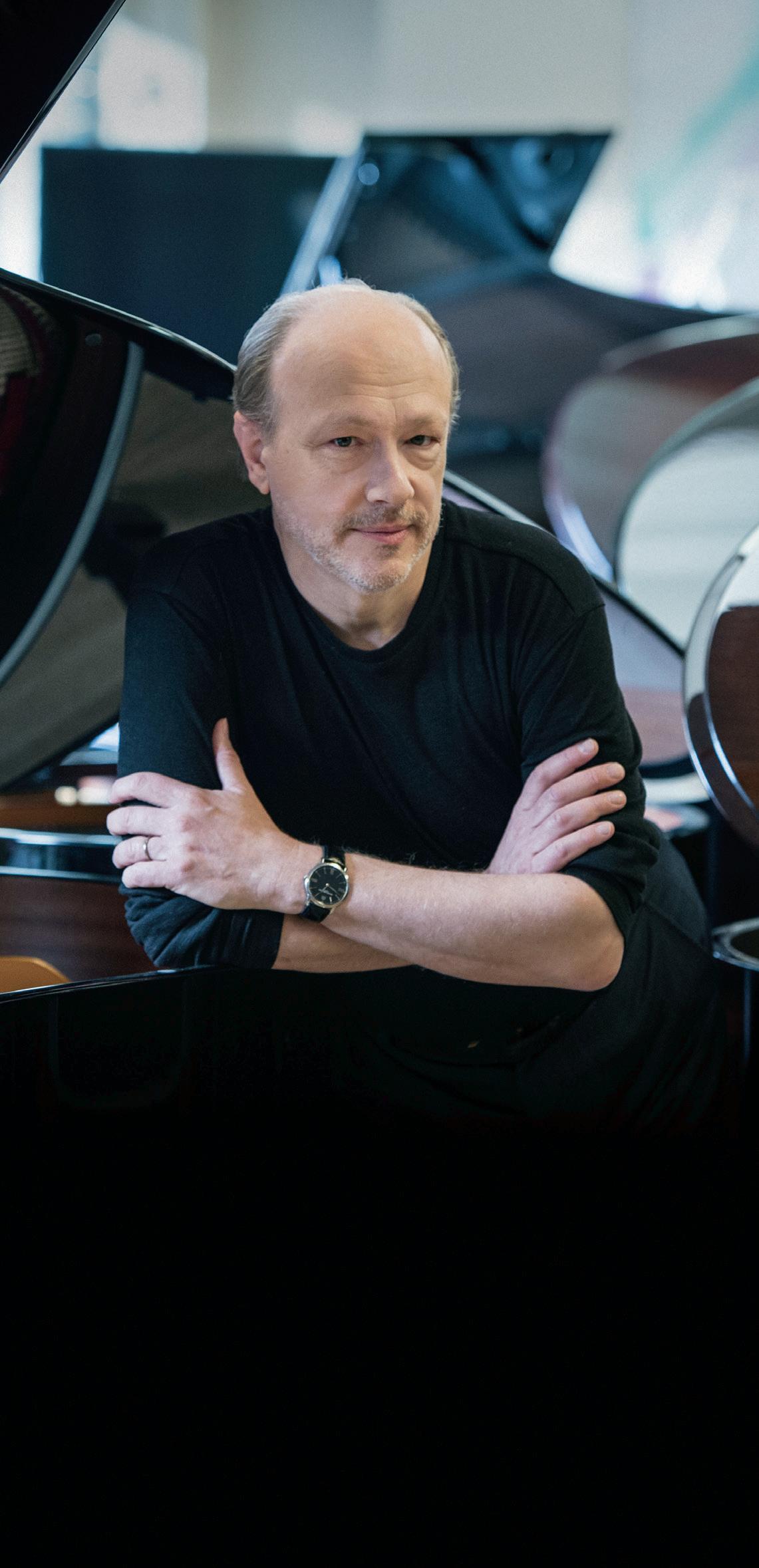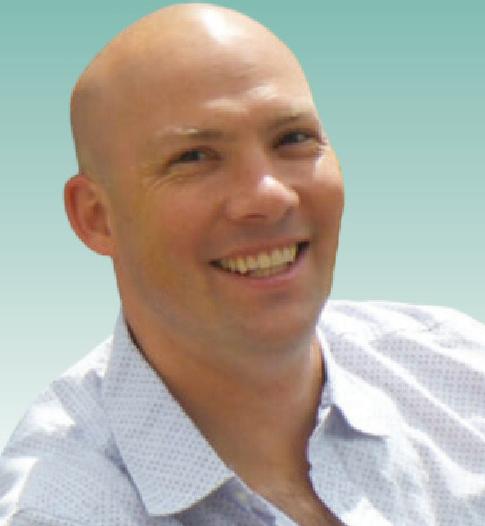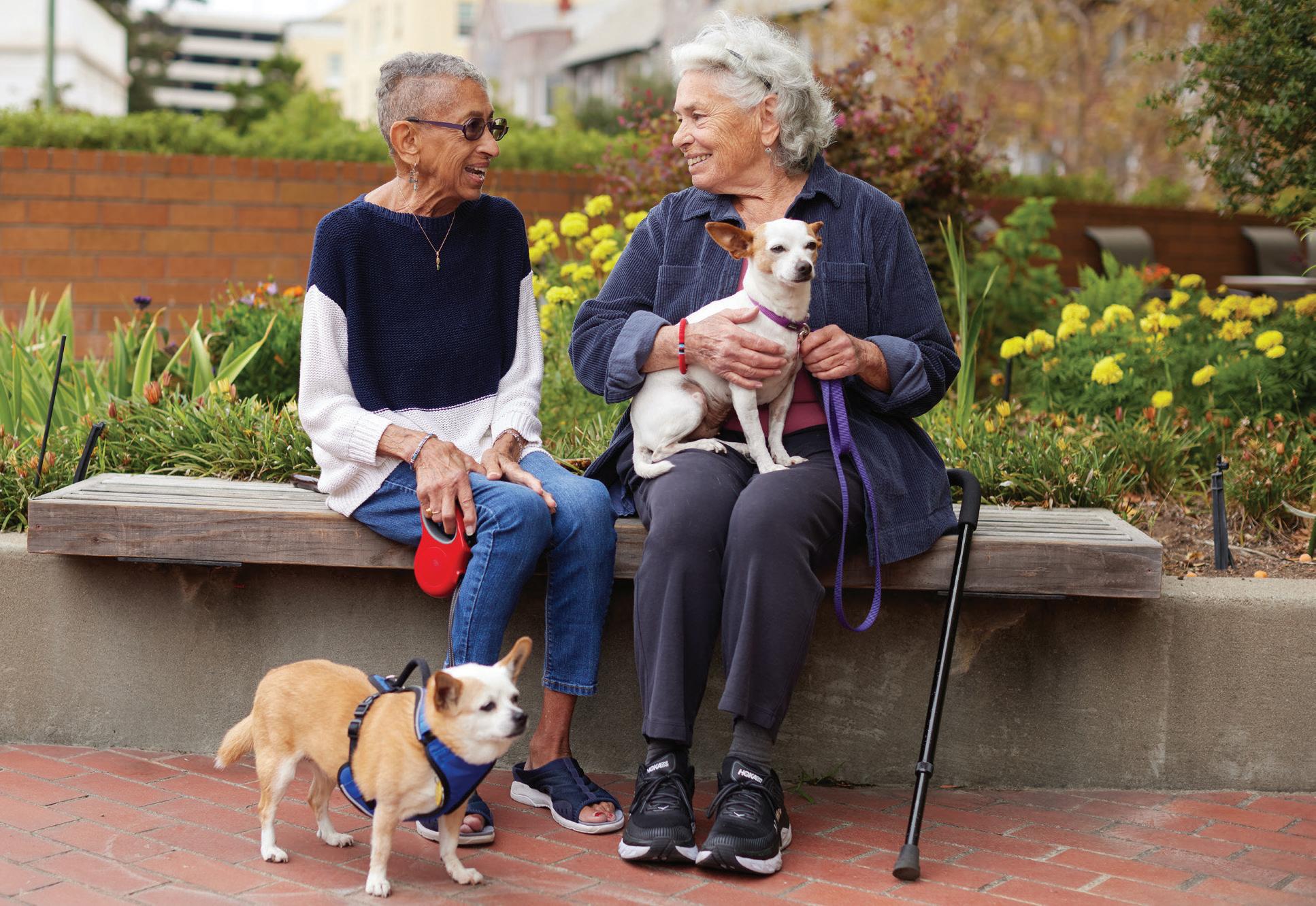

























GLOBAL KIDS
And not a fowl among them.



























And not a fowl among them.

Many moons ago, my preschool teacher asked each of us kids sitting in a circle to share our race or ethnic heritage. One by one, my classmates proudly declared that they were “Korean” or “Black” or “white.”
When it was my turn, I stood up and said, “I’m chicken!”—crossing the signals of being told I was “Chicana,” or Mexican American, to hilarious e ect.
Thankfully, I no longer identify as poultry. But now, more than ever, I know that how we define ourselves matters. Someone who embodies this unapologetically is our cover star, Rita Moreno. Aside from her many gifts to the stage and screen, as well as her activism, I’m awed and inspired by her powerful sense of self, her defiance of traditional limitations, her wit and her
Je rey Edalatpour’s writing about arts, food and culture has appeared in SF Weekly, Metro Silicon Valley, East Bay Express and KQED Arts.
honesty. It’s a delight to feature her in this year’s premiere issue.
Just as our life stories define and unite us, the care we put into where we live is a reflection of our community. Constantly under threat by a litany of complex challenges, our connections to nature through green spaces like Lake Merritt are critical as sources of recreation and respite.

Language is another powerful tool for connection, as bilingualism can not only increase empathy but also expand our worldview and appreciation of diversity. That kind of multicultural reverence informs the music and activism of Naima Shalhoub, a local vocalist inspired by her trips to Lebanon and her work with prisoners there, as well as in the Bay Area.
World travels likewise influenced the

Lou Fancher has been published in the Diablo Magazine, the Oakland Tribune, InDance, San Francisco Classical Voice, SF Weekly, WIRED.com and elsewhere.
Janis Hashe regularly contributes to the East Bay Express and other Bay Area publications.

owners of The Punchdown, a natural wine bar and bottle shop in Oakland. After paving the way for orange and natural wines to thrive locally, the shop owners’ passion for the “magical beverage” was validated by this year’s nomination for a James Beard Award.
Innovation is clearly in the DNA of the East Bay. And it’s in the fabric of this area’s future. We explore how one school’s project-based learning allows students to spend time forming solutions to complex problems—a skill that’ll certainly be useful in the years to come.
From education and ecology to the arts and public spaces, we East Bayers are forward thinkers connected to each other and the world through our stories, our cultures and our most innovative imaginings. – Samantha Campos, Editor
Michael Giotis is a Bay Area based poet and author with a professional background in ecological entrepreneurship.
j. poet has been writing about music for most of his adult life and has interviewed a wide spectrum of artists, including Leonard Cohen, Merle Haggard and Godzilla. He lives in San Francisco.




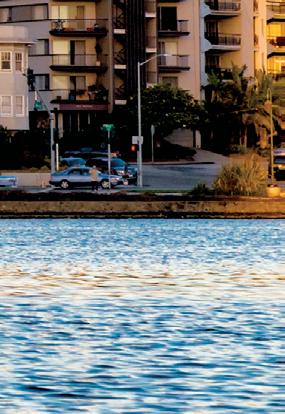




 BY Lou Fancher
BY Lou Fancher
Local residents and frequent visitors to Lake Merritt might think they know everything about what has long been considered a “crown jewel” of Oakland. But much like an image appearing in a mirror held up to the city in which it is a centerpiece, the lake that is actually a lagoon and harbors the nation's first wildlife refuge reflects a layered, complex, intriguing history.
An especially complicated and precarious profile appears during







contemporary times as energy leans into building and housing developments and urban green spaces are increasingly at risk. Casting its wave into the future, aspirations for Lake Merritt are swept up and tossed by topical issues relevant to nature preservation in cities: the impacts of climate change on flooding, toxic stormwater runo s, civic fiscal precarity and tight budgets during economic downturns, and lack of public awareness and knowledge regarding conservation.
Other issues include, realistically,


crime, homelessness, wanton disregard or ignorance about the Earth’s precious, dwindling natural resources, and broad-based misunderstandings about science and the interdependency of the ecosystem that connects human welfare to that of wildlife, plants, trees, soil, water and other elements found in green areas of urban landscapes.
Oakland Council President Nikki Fortunato Bas has been a resident of District 2, where Lake Merritt is located, for more than two decades. Bas
And for 35 years, The Cooperative Cleaning Company has met this need for the East Bay and Southern Marin Counties’ most discerning clients. CCC delivers exceptional service with a highly reliable, steady staff of professionals whose compensation, platinum level health, dental and vision care, PTO, and 401K benefits exceeds anything offered to housekeepers in the Bay Area, if not the industry as a whole. Licensed. Bonded. Insured.




«
emphasized in an interview the lake’s future revolves around preserving its ecology, all-hands-on-deck community involvement, and fostering an environment that is inclusive, accessible and equitable. “We need everyone who visits to be involved: neighbors, visitors, city staff and people connected with places working on the frontline, like the Lake Merritt Institute,” she said.
The Lake Merritt Institute, founded in 1992 by Dr. Richard Bailey, is a nonprofit corporation that works to keep clean and educate people about the lake. With a workforce of volunteer laborers, a board of directors and a small staff led by executive director James Robinson, the organization plays a critical role in preserving the lake’s water quality, protecting the wildlife and communicating the cultural importance of Lake Merritt to the public.
“We rely on organizations like the Lake Merritt Institute and the media and through our City of Oakland programs to let people know about the lake issues,” said Bas. “We always have to work hard and will continue to work to get the city to post more signs that help people recognize it’s a wildlife refuge. But there are also sensitive aspects of how to treat it and take care of it, so through the Parks and Recreation Department and with the new (Mayor-elect Sheng Thao) coming in, I’m hoping the outreach will increase. I’ve heard her speak about the importance of outdoor spaces, and I plan to speak with her about all of our city parks, not just Lake Merritt.”
While championing recent improvements and upgrades such as the twice-a-day restroom cleaning (up from once-a-day), the newly renovated
Pergola, shoreline reinforcements, and painting and repairs to fences, signs and walkways throughout the park, Bas was most enthused about an initiative launched in the summer of 2022.
“I funded a pilot program of park stewards who are out at the lake educating users about permitting, litter container locations, noise and safety regulations and practices,” she said. “The program was started with mid-cycle city budget funds in June and began in July. If it goes well, it will continue, and I expect that to happen.”
Bas said the park stewards are predominantly people from Oakland who know the community well. “All of the stewards went through interviews and a long hiring process to make sure they have high-level interpersonal skills. Also, they’re trained in de-escalation tactics, so they’re good at dealing with the public and any issues that come up.”
Lake Merritt’s 3.4 mile circumference
occupies roughly 155 acres of land. Composed of a mix of freshwater and saltwater, the depth varies and depends on water flowing in from tidal estuaries and the amount of rainfall. The fivepiece archipelago of islands that house an unusual avian assortment with dozens of species of birds was sculpted more than 100 years ago from leftover construction dirt. As the City of Oakland grew rapidly in the early 1800s, the lagoon that sits on what was originally Ohlone land was colonized; the land desecrated and the lake turned into an odiferous, sewage dump.
A cleanup driven more by commerce than environmentalism was begun in 1869 by Samuel Merritt, a wealthy physician and the city’s 13th mayor. He hoped to hide the stench, considered a deterrent to developers, and in 1870, Lake Merritt became the nation’s first wildlife refuge. Sewer pipes were redirected so wastewater went to water treatment plants, and in 1985, the lake was

























dredged to remove polluted sediment. In 2006, the city invested $1 million, making improvements by stabilizing lake edges, expunging invasive plant species, installing a new irrigation system, and adding living trees and foliage.
More recently, trash visible on the lake sparked a response that led to “Adopt a Storm Drain”and “We Mean Clean,” county programs to support a cleaner watershed and estuary. Funds from Measure DD were directed to water quality improvements, increased bike and pedestrian access, wetland restoration and other measures. Discussions between the city and Alameda County about additional improvements continue in 2023.
The Lake Merritt Institute’s Robinson recalled in a separate interview his introduction to Lake Merritt. “I was raised and went to school in Oakland and for years, I never went near it. When I was young, most people thought it was a landfill, and people talked about dead people being found in it. It wasn’t until high school that I started to visit. It was Dr. Bailey who told me about the wildlife and about the difference between a storm drain and a sewer,” he recalled.
Robinson remembers feeling surprised when he learned from Bailey that the city’s sewers deliver water entirely to water treatment centers and only storm drains connect directly into nearby bodies of water. Lake Merritt has more than 63 storm drains.
“I was fascinated that the majority of trash you see and toxins in the lake came from storm drains,” he said. “Trash and lawn pesticides and refuse from roofs, yards and gardens wash in from surrounding neighborhoods and come
into the lake when it rains. Why did that interest me? I suppose because I used to watch Ninja Turtles and I thought they lived in sewers—that’s what they always said on the show—but they actually lived in a storm drain. It caught my attention when I learned about it from Dr. Bailey and then watching the show, I realized the differences.”
Soon, Robinson was kayaking around the lake, enjoying the birds and wildlife, finding a vested interest in preserving it. “I had a genuine connection. It was all about people relating to people. Being out on the lake, with access to water, I found out all the rumors were for the most part false. It was an amazing experience. It’s important to build that connection and then, when you care about it, no one needs to prod you to go out and make sure it’s doing alright.”
Robinson said he’d love to see the endless empty chip bags, water bottles, food wrappers, plastic containers and cigarette butts eliminated. “We see the birds eating the trash, which is so disturbing. If people want to help, volunteering to clean up and calling local city leaders to advocate for a tax on plastics or a ban on containers are two steps that will have immediate impacts. When styrofoam takeout containers were banned, data showed a significant decrease in that form of trash in the lake.”
During the pandemic, and especially after disinformation spread on mainstream and social media concerning a common summer algae bloom that caused the water to turn brackish and a fish die-off, Robinson said public interest in the lake’s purity spiked. “People emailed, called with concern for about a month. People wanted to help, to make
donations,” he recalled. “We went from 20 emails a day to 100, and from five calls on average daily to 50 calls a day.”
After the fervor died down, Robinson said public attention returned to the city’s perennial and persistent preoccupations: homelessness, crime, social injustice, gun violence, inequities in commerce and education and more. The institute’s usual need for more volunteers resumed and continues, especially during the rainy season when inclement weather means less people are willing to join in to pick up trash or pull invasive weeds.
Asked about the impact of the pandemic on Lake Merritt and the public’s relationship with outdoor spaces and recreation, Bas said, “We’ve been many years living with COVID, and the reality is that COVID continues. That means outdoor spaces continue to be critical. In addition to Lake Merritt, it’s all the local parks we need to protect.
“I also have San Antonio Park in my district. It is well programmed with things like the Malcolm X Jazz Festival, community food distribution days and lots of recreational programming. We have to make sure people activate neighborhood parks in addition to Lake Merritt. If we have proper capacity and activity at those parks, it will help the lake because it will reduce the chance of overpopulating the one location.”
“The heart of preserving Lake Merritt is giving people reasons to care,” said Robinson. “Lake Merritt indicates the community’s greater health. It’s true connection that matters, and once that’s established in someone, it won’t ever die.”
For more information, visit lakemerrittinstitute.org or oaklandca.gov.



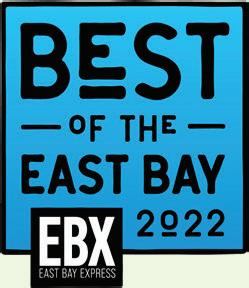







The only thing cold about Rita Moreno when we speak is the fact that she has one. Otherwise, the “EGOT” actress—one of an elite group of actors crowned with the theater industry’s prestigious Emmy, Grammy, Oscar and Tony awards—is warm, salty, even fiery, and only occasionally pauses as if about to sneeze or grumbles like a Christmas Carol curmudgeon about her raspy voice.



















» “I have a slight cold, and that’s why I sound so funny. I haven’t been touched by any germs until Thanksgiving. I was with my daughter and her in-laws, and my daughter, her husband and myself, we all got a mild cold… drives me nuts. Wait, wait, let me turn the sound off on this broadcast. I’m a real news hound, you know. There, it’s off. Now, where were we?”
Where we are, or at least where Moreno is during our conversation, is back in her beloved home located high in the Berkeley Hills. Poised on the precipice of her 91st birthday on Dec. 11, she has just returned from three whirlwind weeks of hotel living and appearances—talks at colleges and other
venues, a Disney television special, work on a movie coming out in 2023 and more—all of which left her clamoring for her very own home, bed, pillow and snacks. I ask her if she is ever alone enough to get lonely.
She tells me she lives in a “fancyschmancy house” with sunsets “like you’ve never seen in your life,” which launches her into several stories that frequently start out gruff and wind into dizzy-in-love territory.
“For years, we’ve had really crappy roads up here that are shocking. Other than that, I love Berkeley. I wouldn’t be anywhere else. Oh no, I have to correct that. I still have my apartment in New York. I’m a New Yorker and
so is my daughter, Fernanda. I’ve just been invited to be on The View in New York in January, and I’m saying, ‘Yes! I’ll go!’ We get to see incredible plays and performances and eat in places I would normally not eat in. It will be a wonderful time.”

But it won’t be the same as Berkeley, to which she and her late husband, cardiologist Leonard Gordon, who died in 2010, moved to be closer to their daughter.
“She married the young man she was seeing, so we just stayed, built this house. I love the people here. I love the opinionated women here. That’s the first thing I noticed when I came up here from Los Angeles. I loved the people


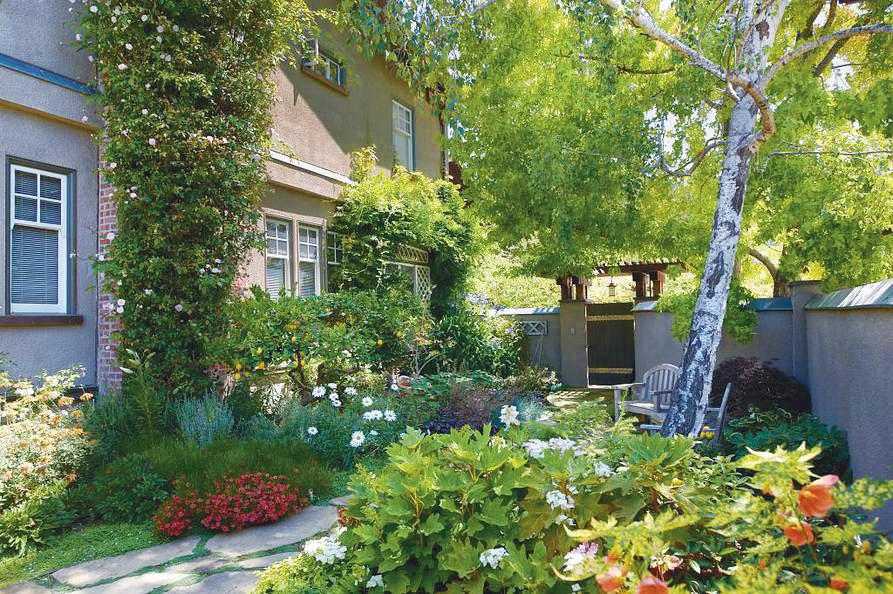
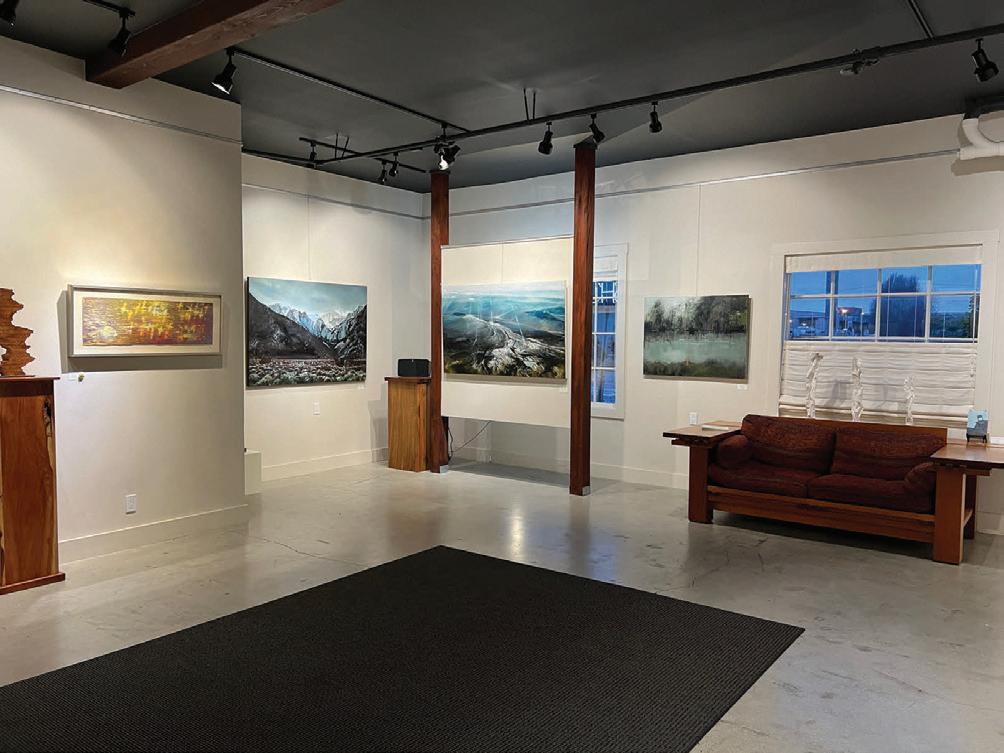
















» who would write angry letters to the editor. I thought, oh, those are my kind of women. I also love Berkeley’s charm. It’s funny, there’s something a little wacky, which I adore. Let’s put it this way, it’s certainly not Los Angeles, and that’s a good thing.”
Contributing another good thing to Berkeley in 2023, Moreno will appear Feb. 26 in a conversation at Cal Performances’ Zellerbach Hall on the UC Berkeley campus. It’s likely the Puerto Rican actor who has risen to iconic status will speak with vigorous energy about key experiences she has had during her seven-decade career.
That career spans work on television, Broadway and theatrical stage productions—and in films such as her Academy award-winning turn as Anita in 1961’s West Side Story and the reimagined 2021 West Side Story directed by Steven Spielberg and written by Tony Kushner, and in which Moreno plays a new character, Valentina.
The conversation may touch on the rigorous, one-woman show she performed in 2011 at Berkeley Rep, Rita Moreno: Life Without Makeup. Far from a nostalgic trip down memory lane, she will without a doubt leap from every angle to address some of her passions: racism and sexism in the entertainment industry, the importance of her not only appearing in the Spielberg film but being credited as one of the producers.
She can’t help but include talk of the “shot knees” of a 91-year-old performing artist, a suicide attempt years ago and a real-life assault she suffered that are included in the documentary, Rita Moreno: Just a Girl Who Decided to Go For It, and life
lessons learned from great loves and adventures she has had: Marlon Brando, Elvis Presley, and participating in the Women’s March on Washington.
“The Women’s March was one of my greatest experiences. You know, I’m old, but I can walk. I’ve been around for 91 years, so I have a lot to say. I have opinions. I’m adamant about certain things. I’m an activist. I’m a political person.”
I ask if her tongue is looser because she is nearly 91, and she says, “Absolutely. I don’t stint. I’m salty. I’m raucous, I love to laugh, I get angry at social conditions. None of that is hidden from the public. I don’t hold back.”
Proving the reins are off, Moreno gallops on: “While I’m remembering, I want to tell you what audiences are in for when I appear. It’s not the usual talk, talk, talk. It’s a conversation. That’s when I’m at my best, funniest, most touching. I’m appearing with someone and opining my ass off and that’s fun. I have hilarious stories to tell, and I have a great sense of humor about myself and my life.
“I stopped doing talks because they don’t have half the effect on the audience that a conversation has. I just tell stories, the audience laughs a lot, and there’s a tear or two shed sometimes. I never know what I will say. I never know what I will be asked. That’s the exciting part of it.”
When I consider the package that is Moreno—the blend up superwoman confidence and a performer’s needy desires—it is complex. Moreno appears to thrive on attention, craves to please an audience, aspires to otherworldly perfection that includes not only her
artistry, but the ability to remember the names of hundreds of people she meets each year and to defy aging joints that leave her to say, “Bending knees is a chore. No more pliés, my dear. But I’m not crippled.”
At the same time, there’s no hesitation in her voice when she says she is “very, very good at storytelling” and “very kind and thoughtful, with a great sense of humor” and skilled at “not making jokes like standup,” but making people laugh by telling them about situations in her life she finds funny. “I’m complex? Well that’s interesting. No one has ever called me complex. What do you think makes me complex?” she asks.
I mention again this alchemy of confidence and vulnerability, but also another fact she has told me. In addition to the physiological changes due to aging, nouns and Moreno have become mortal enemies. The names of things, and especially names of people, are things her brain doesn’t want to remember.
“It makes me nuts. Movie star names, names I know really well. Sometimes the names of objects, but mostly it’s about people. Of course, I could be less lucky and not be able to speak or have a stutter. I can’t complain, but it does make me crazy. The name eventually comes to me, but it’s after I’ve forgotten it and it’s five minutes later, and that’s not useful.
“Part of the problem is that even when this was not happening as it is now, I never listened to names when I first heard them. It’s because when I’m introduced, it’s to people I’m not likely to ever see again. My life is filled with strangers. It became habit, and then in the rare times I’d run into someone »

























again, I’d feel so embarrassed because I couldn’t remember their name.”
See? I say to her. Complicated cross-wiring: wanting to please people, speaking truth with “no bullshit”—her words—and being well-rehearsed with little guilt in forgetting personal touches like people’s names.
“You’re right, I’m complicated.” She issues a big, husky laugh, followed by a few coughs. “How am I complex and keep going? Life lessons. It’s having the ability to learn from your life, from things that happened, from anxiety I felt. Being in psychotherapy was the magic in it all. If it had not been for my going to see someone in-and-out for eight years, I wouldn’t be this Rita Moreno you’re talking to right now. Therapy is what shaped my life from age 23 on. I’m a person who learns from life lessons. I examine all kinds of stuff.”
Moreno is observant and sensitive to human behaviors and individual quirks, part of an actor’s job. Inevitably, that orientation leads to self-examination. She believes people resist psychotherapy and shouldn’t.
“A therapist presents a mirror. That’s what you can get from a good therapist: This is what I see, what I hear, where you are wrong, where you are right, this path is a good one, that one not so much. You learn about negative patterns you keep repeating. Why do I always find the wrong guy, for instance.”
Having recognized and broken free of patterns and finding herself in tremendous demand during the last 10 years, Moreno says her “sudden” popularity is a mystery. Perhaps it is because she no longer tries to please everyone, I suggest. I mention as an example one topic she addresses with forceful protest in interviews and appearances: the continuing underrepresentation of Latin actors and culture in films, despite her and other Latin actors’ success.
“With respect to Latin actors—not just women, but all—we are still severely underrepresented. Something about being Latin in the film profession keeps us back. Someone suggested to me recently that the reason is that Hispanics, we come from many different countries.
We tend to silo ourselves. Regardless of if we’re Argentinian, Puerto Rican, Cuban or Mexican, she feels we need to come together in a more serious, political way. Why, as a community, have we still not made it in films? It enrages me. We have such talent in our community. What the hell is going on here? It’s bizarre. She may have a point. We need to hold our hands together.”
Moreno is unafraid to admit she is surprised but also pleased that she is today heard and held with greater regard and respect. “People listen to me. The resurgence, it’s crazy.” She has just wrapped up work on a Disney/ABC special of Beauty and the Beast that has Martin Short playing the Candelabra and the singer, H.E.R., playing Belle.
“It has incredible costumes and sets. I am the narrator who is not just voice-over, but I am visible and present these things. I think it drops on Dec. 15. It’s spectacular. And then there’s the movie, 80 for Brady, about four old gals going on a road trip to see Tom Brady and coming in February. It has me, Jane Fonda, Lily Tomlin and… oh, where is that name? (Earlier, she easily recalls the fourth actor is Sally Field.) This is the kind of thing that drives me nuts. That’s my story, morning glory,” she says. As we say our goodbyes, Moreno tells me I must come to the Berkeley event and stop backstage to say hello in person. I say yes, on one condition. She must promise not to worry about remembering my name. “You can call me Agatha, or any other name, and I’ll act like it’s the real deal.” Moreno delivers another long, deep-chested, hearty laugh and says, playing along with the joke, “Oh, I like anyone named Agatha. I can’t wait to meet her.” ❤
‘I love Berkeley… I love the people here. I love the opinionated women here. I also love Berkeley’s charm. It’s funny, there’s something a little wacky, which I adore. It’s certainly not Los Angeles, and that’s a good thing.’
RITA MORENO








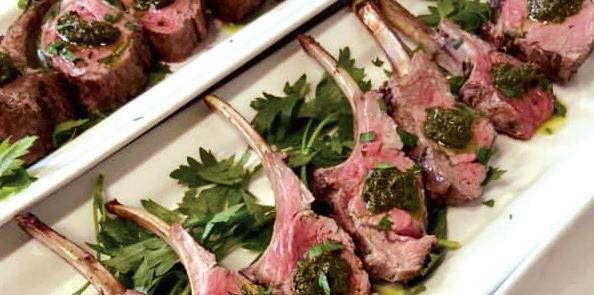

 BY Janis Hashe
BY Janis Hashe
The evidence is overwhelming: Being bilingual in today’s world is a huge advantage. Studies have consistently revealed the “brain benefits” of bilingual education. A 2016 NPR article contains this quote: ‘“bilingualism is an experience that shapes our brain for a lifetime,’ in the words of Gigi Luk, an associate professor at Harvard's Graduate School of Education.”














The article goes on to cite varied studies that found bilingual education boosts the skill of “code switching” (a subset of executive function); leads to increased empathy, as kids have to learn to follow social cues to know which language to use; accelerates English reading skills; enhances school performance and engagement; teaches the value of diversity; and—eventually— provides protection against cognitive decline and dementia.
Then there’s the very practical side. In a blog called, “The Benefits of Bilingualism In Business,” organization United Language Group cites advantages in job applications, business travel and networking, tapping into growing client pools in places such as South America and China, and higher salaries for those who are bilingual.
Other studies support the idea that starting bilingual education as early as possible is ideal. And, fortunately for East Bay parents, there are a number of schools offering bilingual immersion education, some including instruction for children as young as pre-K. The following are some options.

Founded in 1976 by parents who wanted their children to speak French as well as English, Ecole Bilingue’s success is the result of several factors, according to head of school Sebastien Robert.
“First, the program itself, which is based on the French National Curriculum.” Growing out of the Enlightenment period, this curriculum
NI HAO Shu Ren parents want MandarinChinese bilingual education and cultural connection for their pre-K and elementary-age children.
emphasizes high standards, critical thinking “and is cross-project based,” Robert explained. Second, the school hires the best teachers from France, trained not only in pedagogy, but also in child development. And third, he said, “is that we are a community-based school with a great level of parent involvement.”
Seventy percent of these students do not speak French at home, but the school provides resources and videos for parents, as well as play-based activities in French for younger students. Additionally, through a partnership with the Alliance Francais, parents can learn French themselves, if they choose.
Ecole Bilingue offers three learning tracks: core program Section Internationale Americaine, which begins at pre-K, and includes all subject matter; the Accelerated French program, which
allows students enrolling later than pre-K to take two hours per day of French immersion classes, with the goal of rejoining the core program within two years; and a Middle School International Track, in which there is more instruction in English and very small class sizes.
Students in all three tracks become “not just bilingual, but bicultural,” said Robert. “They are able to step back and look at concepts and perspectives, and question them.”
And every child is ready for a second language, he said, noting that Ecole Bilingue is able to accommodate different learning styles and abilities. He suggested that interested parents attend a pre-K class to “see how the students are thriving.”
The school is committed to making its programs affordable. “Seventy percent of our budget is dedicated to tuition assistance, and 50% of our students receive assistance,” Robert said.
By 2050, the school’s website states, French will be the second-most-spoken language in the world. Speaking French will have big benefits, as French-speaking countries in Africa, for example, become more prominent on the world stage. “In the 21st century, we are looking at what students need to become global citizens,” said Robert.
Established in 2006 by a group of parents and professional educators, Escuela Bilingüe Internacional (EBI) was created because, at the time, there were no Spanish-English independent schools in the Bay Area, and no
Held on O’Dowd’s friendly campus in the foothills of East Oakland, Summer Academy is an opportunity for students entering grades 6–8 to inspire their curiosity.
Offering robust academic and enrichment courses, from Math and Spanish, to Drama and Gardening, students develop social-emotional, creative, and intellectual skills, all while getting to know the O’Dowd campus.
“The Middle School Camp was a fantastic experience for my daughter. All the teachers and counselors were so warm. It’s why we ultimately chose O’Dowd for high school.”
— Parent of a Current 12th Grader
O’Dowd’s holistic Summer Academy encourages selfexploration for middle schoolers, with small classes, hands-on learning, and fun group activities.
With a flexible morning and afternoon schedule, and free lunch for students who enroll in 3 or more classes, Summer Academy is an awesome way to explore what it means to be a Dragon!

Spanish-English bilingual programs beyond the 5th grade.
The founders determined to build a dual-immersion school that would serve students from pre-K through 8th grade. The goal was to create a program based on the best teaching and learning practices from around the world, which would prepare children in both English and Spanish for the highest academic levels. Also vital were the cognitive, social and cultural benefits of multilingualism.
Since the school’s founding in Oakland, it has expanded to include a second campus in Emeryville.
Escuela Bilingüe Internacional uses the International Baccalaureate (IB) coordinated curriculum programmes, including the IB Primary Years Programme, for students in pre-K to 5th grade, and the IB Middle Years Programme, for students in grades 6 to 8. Schools using these programmes must be officially authorized by the International Baccalaureate in order
to teach the IB programmes and to be recognized as an IB World school.
The focus of IB programmes is “an integrated continuum of international education… [encouraging] both personal and academic achievement by challenging students to excel in their studies as well as in their personal development,” according to EBI materials.
In the pre-K program, faculty use only Spanish in the classroom. Non-Spanishspeaking students are supported with signs, gestures, facial expressions and drawings to facilitate their understanding and language acquisition. But, children can respond in their mother tongue while being encouraged to use Spanish more frequently as they progress. EBI’s Spanish immersion program helps native Spanish-speaking children, reinforcing and developing their home language.
EBI also offers the Aventura Extended Day Program, school-year camps and after-school enrichment programs.
KIDS’ WORLD Pacific Rim International is an accredited Montessori school with immersion programs in Mandarin-English, JapaneseEnglish and Spanish-English.
Tuition assistance is available for families that qualify.
School materials state the overall mission: “It is our belief that international mindedness helps people become their best selves and responsible members of their local and global communities. We strive to instill an international mindset in our students that promotes empathy, encourages an understanding of the complexity and value of diversity, and supports them in recognizing that we are all connected.”
The Montessori school, founded in 1989 as a dual-immersion MandarinEnglish program, PRINTS relocated to its Emeryville campus in 1995. Other milestones include the addition of a Japanese-English program, the 2005 addition of an Upper School program,

Sacred Heart Cathedral’s story is one of innovation and purpose, of serving Bay Area youth since 1852. We have played a part in the history of San Francisco, just as it has played a part in ours. Today, we continue to welcome the Bay Area’s brightest students to our

inclusive community, preparing them for success with a dynamic curriculum, integrated technology, and engagement with enthusiastic and innovative teachers.
Students and their families choose SHC for the strength of our academics, our faith and
values, our extensive array of cocurricular opportunities, and for the warmth of our inclusive and nurturing community. Our students are compassionate, motivated, resourceful, independent, service-oriented leaders who give life to our motto, Enter to Learn, Leave to Serve.
» the founding of a second campus in San Mateo and the addition, at that campus, of a Spanish-English program. PRINTS also offers a program for infants, “Nido.”
Like all accredited Montessori schools, PRINTS operates on the principles developed by Dr. Maria Montessori, including her description of the “four planes of development.” In the classroom, according to PRINTS materials, there are mixed-age groups; children choose activities on their own; activities are presented to children individually or in small groups, in accordance with each child's needs and learning style; and “silence is a reflection of concentration, peace, and order. The environment is calm.”
Other key components of the Montessori method of instruction include individualized lessons; interconnected subjects; uninterrupted blocks of time for students to focus on their work, both individual and group work; and the ability of students to work at their own pace.
PRINTS leadership believe this can contribute to an ideal atmosphere for learning a second language. “Parents frequently remark on how our school environment shifts a child’s worldview,” state school materials. “Firstly, children develop a curiosity and passion for both the second language and the culture in which it is spoken; secondly, children gain the ability to think and communicate in two (or more) languages. Within this environment, bilingualism, along with a genuine understanding and appreciation of internationalism are achieved with ease.”
Financial assistance is available to students in the Elementary and Upper School programs.
Deron Marvin, co-head at Shu Ren International School, pointed to the use of the International Baccalaureate (IB) coordinated curriculum programmes as one aspect that makes Shu Ren stand out to parents seeking Mandarin-Chinese bilingual education for their pre-K and elementary-age children.
“Many families in this area [Berkeley] are culturally mixed. They want their children to not only be familiar with Mandarin, but to get in touch with their cultural heritage,” Marvin said.
Noting that as many of 80% of Shu Ren parents speak English as their first language, and do not speak Mandarin at home, he explained that the school provides multiple events throughout the year, with the goal of “getting parents on campus as much as possible.”
Shu Ren offers a Parent Community Group, “a distributive leadership model” that includes parents, teachers and staff. The group supports the school as room parents; workshop facilitators; enrichment, event and fundraising support; and field trip chaperones. For example, in January, the group helps produce the Annual Winter Market, in which items produced by students in art classes are sold, and proceeds donated to the Alameda County Food Bank.
Other added benefits offered by the school include a capstone trip for Grade 5 to a Mandarin-speaking country, said
Marvin, as well as a “robust enrichment program,” plus summer camps, some of which are designed for kids exploring if bilingual immersion is right for them. Marvin again emphasized the connection between Shu Ren’s mission and the goals of the International Baccalaureate curriculum. “Our mission is aligned with IB’s goal of creating a more peaceful world,” he said.
Although he was in full agreement with the idea that bilingualism is a significant advantage both today and in the future, aiding college admission as well as career prospects, in his view, the more important element is life enrichment.
“It’s true China is center stage right now,” he said. “But for most of our parents, it’s much more about reconnecting their kids to their cultural heritage.”
Parents’ testimonials on the website indicate their satisfaction with the school’s approach.
“From Day 1, our son loved Shu Ren,” wrote one. [He] started mid-year into Pre-K4, enjoyed their fun summer programs and is now loving Kindergarten. Shu Ren offers a focused, inclusive and caring educational program with patient, communicative and experienced IB teachers. Mandarin Immersion is what drew us to Shu Ren, but IB and the teachers are what’s really keeping us here.”
Like the other schools listed above, Shu Ren offers tuition aid/financial assistance to families that qualify. The school recently opened another campus in San Jose. “We’re so happy to have so many families who are interested in what we offer,” Marvin said. “Our growth is a reflection of that.” ❤

Now accepting applications for the 2023-24 school year! Ecole Bilingue de Berkeley is a preschool-8th grade bilingual immersion school where students learn in French and English. We have several entry points:


• Preschool
• Kindergarten
• Grade 1 & 2 Accelerated French Program

• Grade 6 International track
We believe that when students see the world without borders or barriers, they can confidently and capably seize any opportunity. Every day our students learn to speak, write, and think in two
languages, becoming openminded, adaptable learners who discover their best selves while respecting the differences of others. We can’t wait for you to discover our bilingue program or International Middle School. Learn more and schedule your visit on campus now!
 BY Michael Giotis
BY Michael Giotis
Oakland’s Park Day School kindergarten through eighthgrade students are using innovation and systems thinking to lead themselves into the future that in so many ways is already here.
It has become clear that the future, which is rapidly arriving, is already more comprehensible to this new generation than of

The Academy of Alameda K-8 charter school envisions a future where all students are successful, and their destinies are not determined by their demographics. As one of the most diverse schools in California, we embrace and honor what is unique about our students through our K-5 equity studies program and our 6-8 competency-based learning model. Our full-day kindergarten and low-cost afterschool K-8 programs help support working families. THE ACADEMY OF ALAMEDA | 401 Pacific Ave., Alameda | aoaschools.org | 510.748.4017



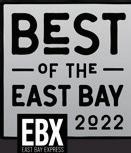



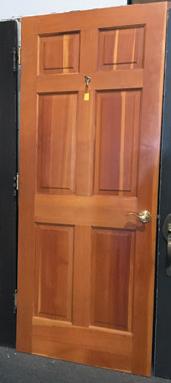







the ones that came before, this writer included. Take, for example, the struggle of those over 30 to grasp the use of preferred pronouns, while the practice is totally clear to a 10 year old with exposure to a marginally trans-supporting culture.
By including innovation and social justice in its curriculum, Park Day School is giving its students the tools to address this future by bringing their own solutions to the table.
When speaking with the school’s director of equity and inclusion, Arjuna Sayyed, for this article, he cited the famous quote from George Washington Carver: “No individual has any right to come into the world and go out of it without leaving behind him distinct and legitimate reasons for having passed through it.”
The work of living with a purpose in mind has to start young, according to Sayyed. “You’re not going to wake up one day at age 21 and be enlightened. [Reflecting and innovating] are muscles, mindsets, practices you have to really cultivate over time.”
According to Ilya Pratt, the Design+Make+Engage program director at Park Day School, hands-on, big picture, project-based learning lets kids really connect their actions with outcomes. “Very complex project-based learning… gives time to talk about whatever it is they’re doing,” said Pratt. Rather than a lesson and discussion, project-based learning lets students spend much longer on a topic, allowing them to look at the topic through multiple lenses. This is especially true when the students work with Pratt in the on-site Innovation Workshop. “When [we are] working with our hands, for a lot of us, our minds get expansive.”
Central to the Park Day School’s educational approach is the Innovation Workshop, a hands-on workshop on campus. Although it may share many of the visual cues of a school woodworking shop, the Innovation Workshop tackles
the implications of projects on a much greater scale. It works by connecting classroom lessons with the problemsolving process called design thinking. “They’re doing all that math with their math teacher, and then I come in and ask them to take on the mindset of engineers,” said Pratt. “Then they start using a laser cutter to quickly prototype out these car bodies,” as one example.
Developed originally to connect product design to the needs of technology users, design thinking has moved far beyond its spiritual home in Silicon Valley. The process emphasizes rapid trial and error to learn what a product’s users actually like, with a healthy attitude toward failure as a mode of learning.
“Very simply put, [design thinking is about] generating solutions and iterating on them,” said Pratt. Despite its power as a learning tool, there are limitations. “As teachers, you can’t always go through all the steps [of the design process]. It’s not always
‘You’re not going to wake up one day at age 21 and be enlightened. [Reflecting and innovating] are muscles, mindsets, practices you have to really cultivate over time.’
—
meaningful to the kids, and you don’t always have time to go through that whole process with kids.”
So the school o ers students practice in another model of problem solving, systems thinking. “It’s really just a way to invite kids to think more deeply about [our curricular endeavors].”

Systems thinking is a way of understanding the world that looks at how the parts of any system contribute to its outputs, and then asking questions like, is this outcome what was intended? Or, how will changing parts of this system a ect the outcome? What improvements can be made? While the approach also comes from working with technology and complex organizational management, its power is in its simplicity.
“You can break down systems thinking for kindergarteners,” said Sayyed. “[For example], a pen is a system, right?” Outcomes of using a pen include: the ink both on the paper and smeared on the fingers, images and letters, and the ideas communicated through writing. This type of thinking allows even the youngest school-aged children to make connections between their physical actions and the impacts of their ideas.


“Then in eighth grade we’re talking about social systems such as school systems, voting systems, etc. Essentially taking any aspect of our world that has some sort of utilitarian function and distilling it down to the parts,” said Sayyed. In this way, the students come to understand that “people are also parts of systems.”
Here is an example of how these approaches can apply to standard curriculum. Across California, sixth graders are taught the various mathematical approaches to determining an average. At Park Day School, when those students enter the Innovation Workshop, they start to think through the meaning of “average” and when it should—or if it even can—be applied.
The project? Crafting an Average Sixth Grader over a biology class skeleton.
“Average sixth grader doesn’t mean white, just because on average there are more white people [in the U.S.],” said Pratt. “The kids are going to get that you can’t average some things out.”

“‘What does it mean to be an average person?’ and suddenly it’s a really expansive way of posing that question,” Pratt continued.
Those teacher-led experiences inspire student-driven projects like the “Queer Counter.” Introduced by a student, the Queer Counter is a place where all queer students at the school can be counted without being exposed. Now a permanent installation on the school grounds, any student can make a tally mark on the counter to identify their sexual orientation, anonymously if they wish. The project recognizes that there is great power in being seen, even if one is not ready to be out.
“The level of empowerment that it gave this group of kids who were more, you know, outside of the traditional social mix, it was just fantastic,” said Pratt. “It was that act of making an object that had a purpose.” ❤
In the projects we usually do in the workshop, if you get something wrong, like building shapes in math, you can more easily see what you did wrong and how to fix it.
Leilani, 7th grade
Something that stood out to me about the Average 6th Grader project is that everyone worked together. We all had our separate pieces, and we had to make adjustments. It came together, and it wasn’t necessarily beautiful, but it was accurate.
Bay, 7th grade
I really liked thinking about me in the big picture—me in the group—and working together to find out more about ourselves.



Josie, 7th grade
For the gender, we did a bit of a mix between the mode and mean. Some people took it from a mathematical perspective and others from a personal / philosophical perspective. We voted.
For me, I’m a visual thinker. This project really helped me see how the systems fit together.
Luca, 7th grade


The owners of The Punchdown named their natural wine bar and bottle shop after a harvest term. During the process of fermentation, winery workers push the grapes down as they’re producing carbon dioxide. “Those are the little bubbles that push the grapes to the top,” explained DC Looney, one of the co-owners. Throughout the winemaking process,
you need to push down on the mixture, ‘for a healthier fermentation.’”
When Looney and his wife and business partner, Lisa Costa, first opened the shop in 2010, they racked their brains to come up with a name. The couple had previously worked at a winery together. “Our main task was doing punchdowns,” he explained. They liked the association of doing that work with their new venture.
In 2022, The Punchdown received a James Beard nomination for outstanding wine program. Twelve years ago, Looney said there weren’t any other natural wine bars in the East Bay. “There was only one in San Francisco, one in Millbrae and one in New York that we knew of,” he said. At the time, he and Costa were only drinking natural wines. And they weren’t as readily available as they are now. It took a great
deal of e ort to source them then. “We decided that’s what we wanted to showcase in our little wine bar,” he said.
Looney learned about wine by traveling around the world and through his studies in Paris and at UC Davis. While he was studying the wine business, the producers that resonated with him were the ones using organic or biodynamic growing methods to grow grapes. That often meant a small family farm rather than something more corporate. The natural wines produced on a small farm tasted di erent to him.
“There’s more variation from year to year,” he said. “It’s just letting the natural yeast and the natural components of the grape ferment into wine without adjusting it.”

When customers stop in at The Punchdown, they can buy bottles of wine or have a glass of wine and a small bite to eat. But Looney and Costa really want people to understand the mindset behind natural wines. “The most important part of wine, in general, is to know and trust what you like,” he said. And not to have someone else tell you that you should like something.

When he was studying, it was hard for him to understand the subjective approach to the scoring system that wine critics used to rate them. “I would taste the wines and the scores didn’t match up to me,” he recalled. That’s why The Punchdown has specialized in and carried a large selection of orange wines. “Almost every single orange wine is di erent,” he said. Most weeks, there are four orange wines by the glass on the menu.
Looney said that orange is the natural color that wine will become »
from white grapes. “White grapes are actually more green and yellow in color,” he explained. When those skins are kept on during fermentation, the wine extracts flavor, the orange color and tannins from them. Orange wine is made in the same way as red wine. “If you just took red grapes and pressed them into a wine, you’d make a white wine,” Looney said. Most of the red color comes from the skins.
When they first opened, Looney and Costa had to explain to everyone what natural and orange wines were, why they were different and why they liked them. They didn’t budge from that framework. After a couple of years of hard work, The Punchdown gained respect and a following. Several people who worked for them later started up their own wine shops or wine bars in Oakland. “It became a whole movement,” Looney said.
That surprised them because The Punchdown started as a two-person
operation. “It was a dark little space and we were doing what we loved, serving good wholesome food with good wholesome wines that are different,” he said. They wanted to showcase something authentic, to expose people to new tastes and flavors, as well as the history and culture behind the wines. Now, natural wines are more accepted.
But on some occasions, they’ve encountered customers who are shocked when they find out that wine is fermented. He believes there’s a huge disconnect between some people’s understanding of the winemaking process and the classic (not natural) wines they’re used to drinking.
“Going back thousands of years, you’re taking a fruit and turning it into this magical beverage that makes you feel good,” he said. “And that evolved into the modern day chardonnay that does not taste fermented. We love and crave that raw, fermented flavor,” Looney said emphatically.
California vineyards are not leading the natural wine industry. Looney said that France is. There is a demand for natural wine in Tokyo, London and New York, but “it’s really in Paris and France where it’s more prevalent there in the culture.” The Punchdown, though, has always supported local winemakers who are growing grapes that align with their beliefs. He calls that approach “more than organic.”
“It’s taking organic to the next level, biodynamics essentially, regenerative farming,” he explained. More than organic is a way of farming the land that’s good for the environment and for the soil. If one has healthy soil, then one can grow healthy fruit without having to adjust the levels of sugar or nutrients to the fermentation process.
“There are expensive cabernets in Napa that have added nutrients because the soil is lifeless,” Looney said. “Then it’s going to be lacking in nitrogen, which you’re going to need to add to the fermentation so it doesn’t taste off or funny.”
The California regions that are maintaining organic vineyards, he notes, are places like Mendocino, Humboldt, Sonoma and around Santa Cruz. “It’s mind blowing that wine is not held up to the same standards as food because it is a food product,” Looney argues. “If you knew what was added into your wine, it might influence what types of wines you would drink.”
The Punchdown, open Sun to Thu 3-9pm and Fri to Sat 12-11pm. 1737 Broadway St., Oakland. 510.788.7877. punchdownwine.com.
‘Going back thousands of years, you’re taking a fruit and turning it into this magical beverage that makes you feel good. And that evolved into the modern day chardonnay that does not taste fermented. We crave that raw, fermented flavor.’
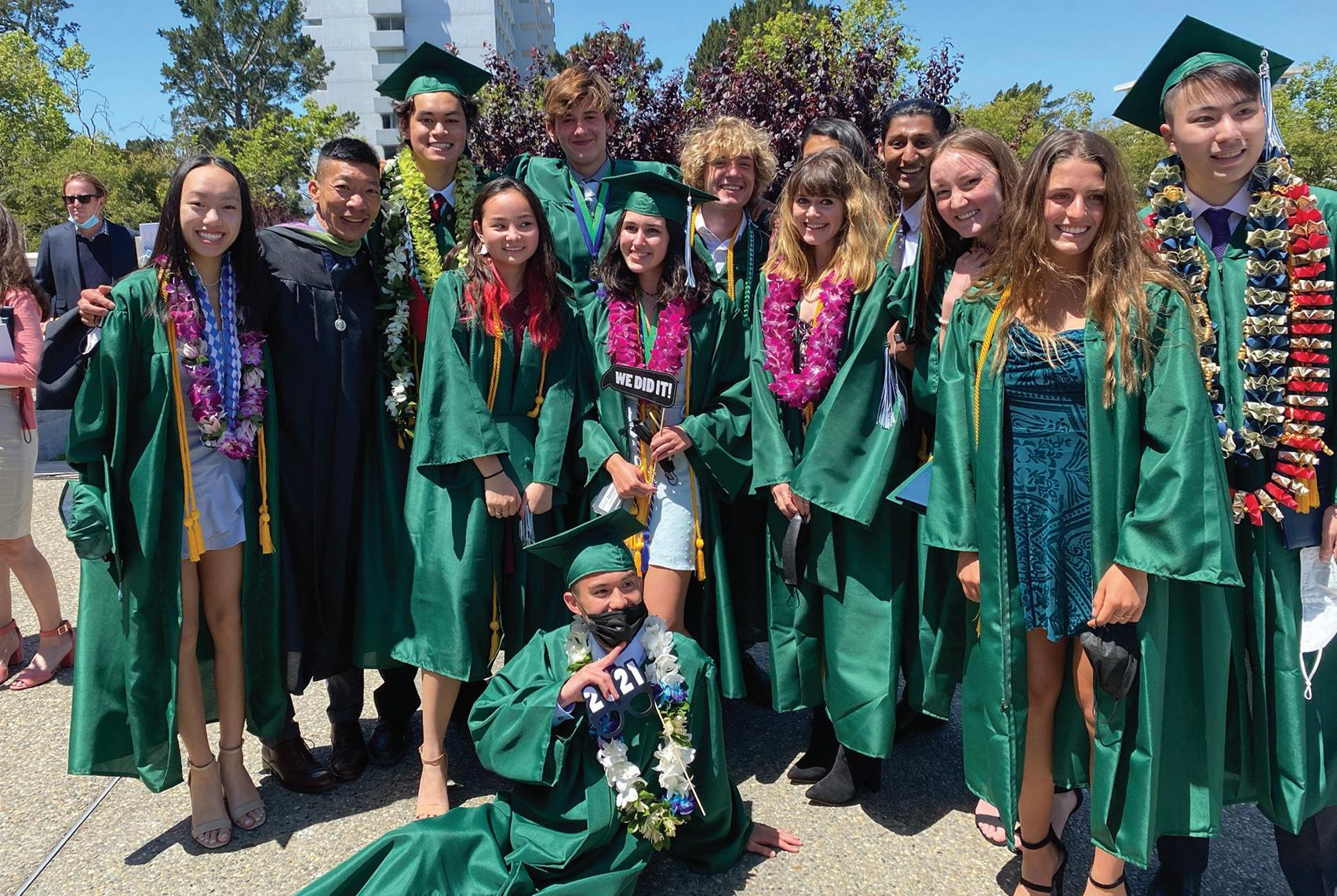


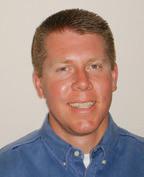

Naima Shalhoub’s first album of original material, Siphr, covers a lot of emotional, geographical and musical ground. It plays like a suite and includes arrangements that draw on Middle Eastern and American modes. It also includes her reinvention of “Lamma Bada Yatathanna,” a song from Moorish Spain that’s more than 1,000
years old. The music was recorded in San Francisco, but Shalhoub said the idea behind it began brewing a few years before, during a trip to Lebanon, her parents’ birthplace.
“I went to Lebanon on tour in 2017 and connected with several grassroots organizations. I visited Roumieh Prison, with the help of Zeina Daccache of Catharsis, an
organization working for justice in Lebanon. I facilitated a music session with 52 incarcerated men, similar to the work I’ve been doing in the women’s prison in San Francisco.
“We wrote lyrics together to blues based on how they felt about being incarcerated. I put it to a melody which became one of the songs on the album, Roumieh Prison Blues. I returned the next
year to visit with family and start researching and exploring the themes for the album. The idea for Siphr was born in an apartment in Beirut.
“When I got back to Oakland, I reached out to my friend, Excentrik (aka Tarik Kazaleh, a Palestinian American multi-instrumentalist and producer, one of the founders of ArabAmerican hip-hop). I told him what I

had in mind, and he said, ‘Let’s do it!’”
With the help of a grant from the Women’s Audio Mission in San Francisco, Shalhoub and Excentrik went into the studio, just prior to the COVID-19 pandemic. They planned the album release for March 2020, which had to be canceled due to the shelter-in-place order.
Siphr opens with “Remembrance,” an
instrumental built around Excentrik’s oud and percussion improvisations and Shalhoub’s wordless vocal hook. The guitar lines on “Rivers in the Desert” are based on the rhythms of Gnawa music from southern Morocco. It’s a slow, soothing tune, a dream about bringing water to the desert. It’s sung in Arabic, with Excentrik’s guitar echoing softly in the background.
« “My dad helped me arrange the melodic line. He has a way of singing, with traditional Arab tonality, that is very indigenous to the region he grew up in in Lebanon. I don’t have it, since I grew up in the States.”
Bass player Marcus Shelby adds his propulsive bassline to “Distraction Suite.”
It’s a blend of free jazz, R&B and funk that features Shalhoub’s scatting and piano playing and Excentrik’s inventive drumming. The song delivers a prayer for serenity in the midst of global discord.
Excentrik overdubbed layers of oud, guitar and percussion to mimic the sound of an orchestra on “Lamma Bada Yatathanna.” The song is in 10/8, with Shalhoub’s lilting Arabic vocal dancing around the beat. Politics take center stage on “Arab Amerikkki.” Its hip-hop rhythm supports a rapped dialogue between Shalhoub and Excentrik that describes the insidious way racism permeates the hearts and souls of the oppressed.
“As I was working on the album, the word ‘siphr’ kept coming to mind. It’s an Arabic word that can be translated as ‘zero.’ In mathematics, it’s the foundation of everything, a historical Arab contribution to the world that rarely gets acknowledged, but it also has a spiritual meaning to me. Grace, or the zero still point, is the foundation of everything one thinks or believes, the things one can’t see, but can feel. Excentrik helped to bring that vision to life with his deep understanding and musical knowledge of Arab and American music.”
Although she was surrounded by music since childhood, Shalhoub had no intention of becoming a performer. Her Lebanese parents played Arab music on the stereo, while she gravitated toward R&B.
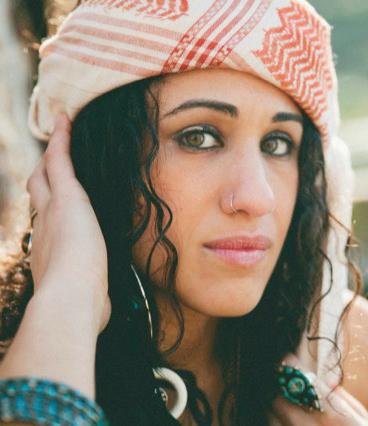
“I took piano lessons starting at four, but stopped in middle school. I taught myself guitar in freshman year of college, but I can read and write music and had a foundation in theory from my early lessons. I was in a competitive vocal jazz ensemble in high school that sparked my interest in jazz, but due to other personal reasons I didn’t pursue music as a profession until I was in grad school. That’s when I wrote my first song. I started performing at concerts to raise money for victims of the earthquake in Haiti in 2010, and did many concerts to support a Free Palestine, so my activism and music were together from the beginning.”
With a master’s degree in postcolonial and cultural anthropology, she began working in the schools of the East Bay and became a restorative justice coordinator for the Oakland Unified School District.
“I saw the linkages between racial and economic injustices intersecting with schools and other institutions.
Restorative and transformative justice brings us together to heal and change systems of oppression. Colonialism isn’t just something in the past, but continues today. I’ve always been moved to collaborate with Indigenous justice movements that focus on building power, remembrance and co-creating the systems of liberation we all deserve—to be able to love and be loved, to live on lands with dignity, honor and joy.”
A few years ago, Shalhoub began holding weekly “Music and Freedom” workshops for the women at the San Francisco County Jail. After a few months, she built a rapport with many of the women and suggested making a live recording of the songs they were singing. San Francisco was leaning towards the progressive side back then, and the sheriff gave Shalhoub permission.
“I invited my band, including Excentrik on Oud and guitar, Aaron Kierbel on percussion, Marcus Shelby on bass and Isaac Ho on keys. I opened with a freedom song—‘Keep Your Eyes on the Prize’—that I rearranged and sang a few originals. Some of the women who wanted to recite poems and tell their stories came on stage with me. It became my debut album (Live in San Francisco County Jail, released on her website and the usual streaming platforms). That experience got me thinking about making a record of my original songs and finally led to Siphr.
“Art is always growing and evolving, as is culture. I want to continue to build a wide community through my music and community work—in the Bay and beyond.”
Siphr is available at naimashalhoub. bandcamp.com and on the artist’s website: naimashalhoub.com.
